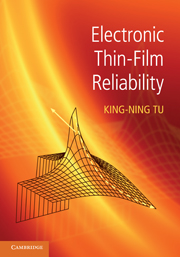Book contents
- Frontmatter
- Dedication
- Contents
- Preface
- 1 Thin-film applications to microelectronic technology
- 2 Thin-film deposition
- 3 Surface energies
- 4 Atomic diffusion in solids
- 5 Applications of the diffusion equation
- 6 Elastic stress and strain in thin films
- 7 Surface kinetic processes on thin films
- 8 Interdiffusion and reaction in thin films
- 9 Grain-boundary diffusion
- 10 Irreversible processes in interconnect and packaging technology
- 11 Electromigration in metals
- 12 Electromigration-induced failure in Al and Cu interconnects
- 13 Thermomigration
- 14 Stress migration in thin films
- 15 Reliability science and analysis
- Appendix A A brief review of thermodynamic functions
- Appendix B Defect concentration in solids
- Appendix C Derivation of Huntington's electron wind force
- Appendix D Elastic constants tables and conversions
- Appendix E Terrace size distribution in Si MBE
- Appendix F Interdiffusion coefficient
- Appendix G Tables of physical properties
- Index
- References
3 - Surface energies
Published online by Cambridge University Press: 05 July 2014
- Frontmatter
- Dedication
- Contents
- Preface
- 1 Thin-film applications to microelectronic technology
- 2 Thin-film deposition
- 3 Surface energies
- 4 Atomic diffusion in solids
- 5 Applications of the diffusion equation
- 6 Elastic stress and strain in thin films
- 7 Surface kinetic processes on thin films
- 8 Interdiffusion and reaction in thin films
- 9 Grain-boundary diffusion
- 10 Irreversible processes in interconnect and packaging technology
- 11 Electromigration in metals
- 12 Electromigration-induced failure in Al and Cu interconnects
- 13 Thermomigration
- 14 Stress migration in thin films
- 15 Reliability science and analysis
- Appendix A A brief review of thermodynamic functions
- Appendix B Defect concentration in solids
- Appendix C Derivation of Huntington's electron wind force
- Appendix D Elastic constants tables and conversions
- Appendix E Terrace size distribution in Si MBE
- Appendix F Interdiffusion coefficient
- Appendix G Tables of physical properties
- Index
- References
Summary
Introduction
Surface energy is an underlying concept in understanding thin-film process. By definition, thin film has a very large surface-to-volume ratio. Surface energy controls the nucleation as well as the heterogeneous epitaxial growth processes. It also plays a key role in many applications of thin films, for example, in MEMS devices. Generally speaking, surface energy is the extra energy expended to create a surface, so surface energy is positive. It is important to know that metals have high surface energies and oxides have low surface energies, so a native oxide can grow on a metal.
The surface energy determines whether or not one material wets another and forms a uniform adherent layer as in heterogeneous epitaxial growth. A material with a very low surface energy will tend to wet a material with a higher surface energy so that epitaxial growth is possible. On the other hand, if the material to be deposited has a higher surface energy than the substrate surface, it tends to form clusters (“ball up”) on the low-surface-energy substrate. The epitaxial growth of a superlattice structure of ABABAB requires that in addition to a good lattice parameter match between A and B, the surface energy of A and B should be nearly the same. There is a well-known wetting principle that if A wets B, B will not wet A but ball up on A. In order to have A wetting B and B wetting A in growing the superlattice, their surface energies should be the same.
- Type
- Chapter
- Information
- Electronic Thin-Film Reliability , pp. 30 - 59Publisher: Cambridge University PressPrint publication year: 2010



